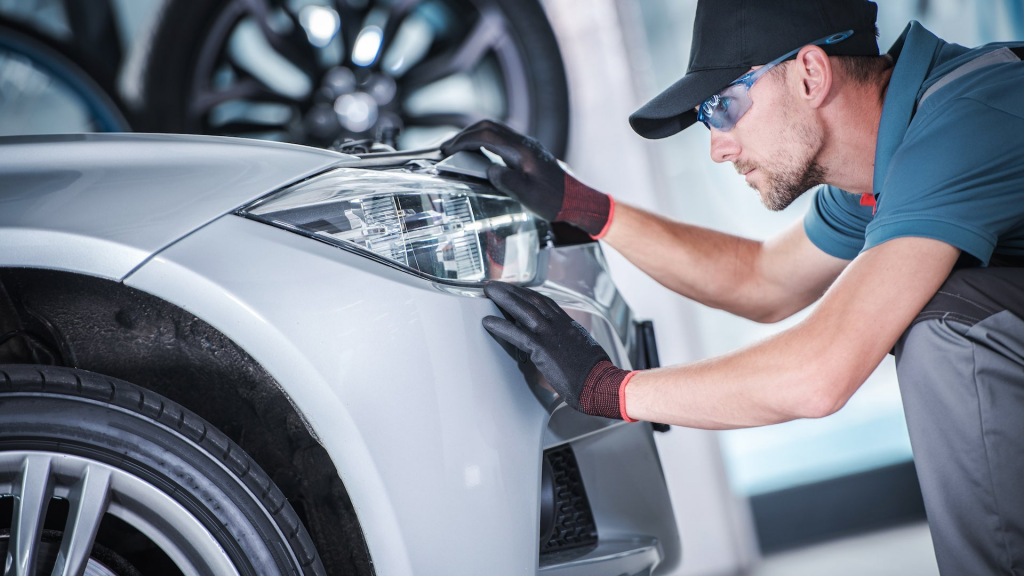
Properly adjusted headlights are essential for safe and effective nighttime driving. Over time, headlights may become misaligned due to vehicle vibrations or accidental impacts. This guide provides a step-by-step process to help you adjust your headlights and ensure optimal visibility on the road.
Step 1: Preparation
- Park your vehicle on a flat surface facing a wall or garage door.
- Ensure that the vehicle is level and the tires are properly inflated.
- Turn off the headlights and engage the parking brake.
Step 2: Determine the Correct Headlight Height
- Consult your vehicle’s owner manual to find the recommended headlight height specifications.
- Measure and mark the height on the wall or garage door using tape or chalk.
Step 3: Locate the Headlight Adjustment Screws
- Open the hood and locate the headlight assembly.
- Identify the vertical and horizontal adjustment screws on the back of the headlight housing. These screws control the up/down and left/right movement of the headlights.
Step 4: Vertical Adjustment
- Use a screwdriver or appropriate tool to adjust the vertical alignment screw.
- Turn the screw clockwise to lower the headlight beam or counterclockwise to raise it.
- Align the headlights with the marked height on the wall or garage door.
Step 5: Horizontal Adjustment
- Use a screwdriver or tool to adjust the horizontal alignment screw.
- Turn the screw clockwise to shift the headlight beam to the right or counterclockwise to the left.
- Align the headlights so that they are symmetrical and not tilted to one side.
Step 6: Test and Fine-Tune
- Turn on the headlights and observe the beam pattern on the wall or garage door.
- Ensure that the light is focused ahead and not too high or low.
- Make any necessary adjustments by repeating steps 4 and 5 until the desired beam pattern is achieved.
Step 7: Repeat for the Other Headlight
- Repeat steps 4-6 for the other headlight to ensure both are properly aligned.
Step 8: Verify Alignment
- Take your vehicle for a test drive to ensure the headlights provide adequate illumination and visibility.
- If you notice any issues or uneven lighting, recheck and readjust the headlights if necessary.
Conclusio
n: Regularly checking and adjusting your headlights is crucial for maintaining safe visibility while driving at night. By following this step-by-step guide, you can properly align your headlights and ensure optimal illumination on the road, enhancing both your safety and the safety of others.
Headlight technology has come a long way since its inception in 1898, but even the most advanced headlights may require occasional adjustments to ensure optimal performance. Properly adjusted headlights are crucial for providing adequate visibility at night while avoiding blinding oncoming drivers. This guide aims to assist vehicle owners in adjusting their headlights, saving them the expense of professional services that typically cost around $40 to $50.
Tools Required:
- Dry erase marker
- Impact driver (optional)
- Multi-tip screwdriver (or socket wrench, depending on vehicle model)
- Pencil
- Tape measure
- Wooden sawhorse (or wall of a building)
Materials Required:
- 4×8-foot sheet of plywood (or wall of a building)
- Deck screws (optional)
- Roll of painter’s tape
Procedure:
- Preparing the Workspace:
- Set up a 4×8-foot sheet of plywood as a makeshift wall or use the wall of a building as a reference surface.
- Secure the plywood to a wooden sawhorse using deck screws, or utilize an existing wall.
- Ensure the area is well-lit and provides a flat, level surface for accurate adjustments.
- Marking the Vertical Reference Line:
- Stand approximately 25 feet away from the makeshift wall or building wall.
- Use a dry erase marker to mark a vertical reference line that corresponds to the center of your vehicle’s front.
- This line will serve as a reference point for aligning the headlights.
- Positioning the Vehicle:
- Park the vehicle on a flat, level surface facing the makeshift wall or building wall.
- Ensure the vehicle is at a reasonable distance from the wall, approximately 25 feet.
- Locating the Adjustment Screws:
- Open the vehicle’s hood and locate the headlight assembly.
- Identify the vertical and horizontal adjustment screws on the back of the headlight housing.
- These screws control the vertical and horizontal movement of the headlights.
- Vertical Adjustment:
- Using a multi-tip screwdriver or socket wrench, adjust the vertical alignment screw to raise or lower the headlight beam.
- Refer to the vehicle’s manual for specific instructions on turning the screw clockwise or counterclockwise.
- Align the headlights so that the beams are parallel to the vertical reference line marked on the makeshift wall or building wall.
- Horizontal Adjustment:
- Adjust the horizontal alignment screw to move the headlight beam left or right.
- Again, consult the vehicle’s manual for the correct turning direction.
- Align the headlights symmetrically, ensuring they are not tilted to one side.
- Testing and Fine-Tuning:
- Turn on the headlights and observe their beam patterns on the makeshift wall or building wall.
- Ensure the light beams are focused ahead and not too high or low.
- Make any necessary adjustments to achieve the desired beam pattern.
- Repeating for the Other Headlight:
- Repeat steps 5-7 for the other headlight to ensure both are properly aligned.
Conclusion: By following this simple step-by-step procedure, vehicle owners can adjust their headlights and enhance nighttime visibility without the need for professional assistance. Regularly checking and adjusting headlights is essential for road safety, as it ensures optimal performance and prevents the blinding of oncoming drivers. This DIY approach saves both time and money, providing a practical solution for maintaining effective headlight functionality.
